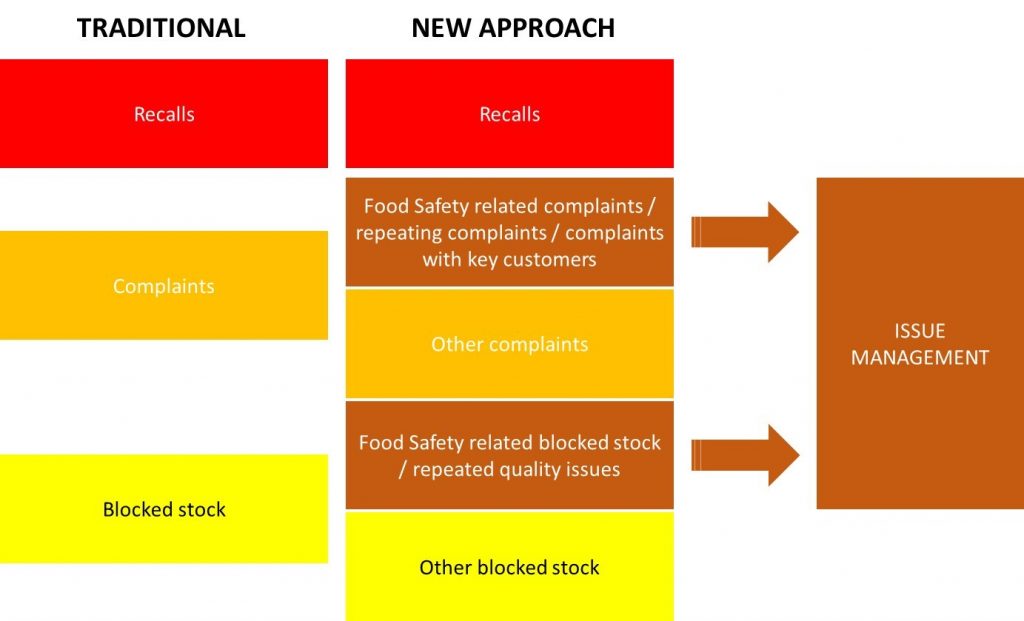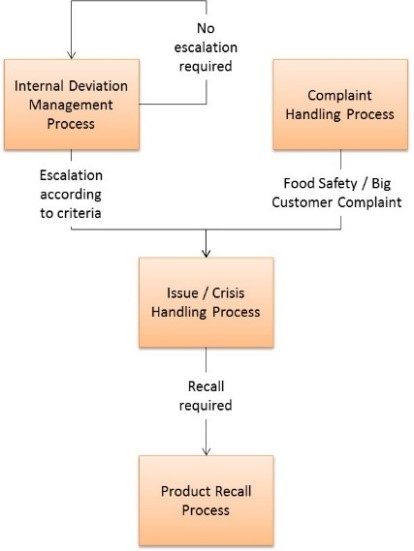Introduction Issue Management
 Most food production businesses face issues from time to time in the area of product quality and food safety. If the company has a strong quality culture most of the issues will stay internal, but might still upset the supply stability of the company. In other companies these issues spread widely outside the borders of the company, resulting in complaints of many customer and in the worst case even product recalls.
Most food production businesses face issues from time to time in the area of product quality and food safety. If the company has a strong quality culture most of the issues will stay internal, but might still upset the supply stability of the company. In other companies these issues spread widely outside the borders of the company, resulting in complaints of many customer and in the worst case even product recalls.
Properly managing issues inside a company is not only necessary to prevent issues from reaching customers, but also at an internal level, strong issue management is a prerequisite for successful quality and food safety management. The main reason for this is that if you want to improve the quality culture and performance of the organization, most often you need to implement necessary improvements. While implementing these you do not wish to have negative distractions and bad press coming from quality and food safety related issues. As Warren Buffet puts it: ” You only have to do a very few things right in your life so long as you don’t do too many things wrong.”
In short, if you as a Quality and Food Safety Manager want to make impact in an organization and really drive for results, you must put into place a proper way to manage and prevent issues. In this article we will discuss the necessary steps you must take to achieve the what of issue management.
Define issues
Before we can make a start with describing the ins and outs of issue management we need to first give a proper definition of issues. Most companies do have the concept of issues in the quality management system, nor are issues defined in the requirements of most of the certification schemes. Most of the time companies have a three-level approach consisting of blocked stock, complaints and product recalls. Of course blocked stock is an internal item and complaints and product recalls are external items.
The definition for issues which we will use in this article is as follows:
- All food safety related complaints
- Repeating complaints for quality reasons (within a certain period and linked to the same product category, production equipment or raw material)
- Complaints with major customers (as you don’t want to upset these)
- Blocked stock for food safety reasons
- Blocked stock for repeating quality reasons (within a certain time period and linked to the same product category, production equipment or raw material)
Graphically the difference between the traditional approach and the new approach can be depicted as shown in the figure below.

For all the issues you want to ensure you manage these with extra attention. Also you want to put into place a clear escalation mechanism for these issues as these might still blow up to a full sized recall in the end. In the coming two sections we will explain the details of issue management and the escalation mechanism.
Issue management & follow-up
The key to proper issue management is pro-activeness from the start. As soon as an organization becomes aware of food safety related issues either from complaints or in the blocked stock, this issue must be raised to the level of the Quality Manager. Especially when it comes to food safety related issues, time is a company’s worst enemy, because before you know it the issue might grow out of hand, consumers might be affected, authorities might get involved and before you know it you are facing a full-blown recall.
This is exactly what proper issue management and follow-up can prevent: an issue becoming a full-blown recall and /or a reason for major customers to be truly upset with your company. As stated it all starts with immediate notification of the Quality Manager of any issue at hand. This does not mean the Quality Manager is responsible to manage all issues personally, but at least he/she needs to be aware.
Next to this it is good practice to keep track of all issues at hand in an organization, which can be simply in Excel. If you follow this link you can download the Issue Management Template in Excel. For each issue you want to nominate an owner. The owner will coordinate all required actions and reports back to the Quality Manger. In very small organization the Quality Manager will often be the owner as well, but still it is good to use the Excel file as it brings all the relevant information into one location. Next to the Excel file you might want to create a folder structure with the issue numbers as folders. In these folders you can store all the related documents per issue, this facilitates proper dossier management in case the issue still evolves to recall and is also very useful to find information afterwards.
For each issue you want to keep track of and discuss during a weekly update meeting the following items:
- Issue Number – unique identifier for each issue
- Date of Issue – the date the issue became known to the organization
- Brief Description of Issue – one liner describing the issue, product and / or customer involved
- Issue Details (including update) – a short status update, which is updated by the issue owner on a weekly basis
- Related Product(s) – names of all products involved in the issue
- Related Customer(s) – names of all customers involved in the issue
- Estimated Impact ($) – estimated financial impact of the issue, as it does not need to be 100% accurate we use several classes.
- Status – the status can either be NEW; In control, ongoing; In control, winding down; CLOSED; Out of control; Potential recall; Recall
- Owner – this is the issue owner (not necessarily the Quality Manager)
- Agreed action numbers (any action that is agreed during the weekly meeting will be logged in a separate action tracking file / tab – refer to the action number here. You can download the action tracking file via this link).
- Final financial impact
By following up all the actions and status updates on a weekly basis you ensure each issue is managed pro-actively and as a result you will see the (financial) impact of issues on the organization going down and over time you will even see less issues, providing you keep on executing on preventive actions as well. The connection of issue management to corrective and preventive actions will be discussed in the last section of this article.
Escalation mechanism
 Next to ensuring issues are managed properly by the issues owners, it is equally important to keep senior management in the loop and have an escalation mechanism in place, just in case an issue does evolve towards a recall situation or a major clash with one or more of the company’s customer(s). Issues and their status should never be a surprise to your senior management. Hence it is important to share the update file after each weekly meeting with the key stakeholders in your organization. Typically these are members of your management team, especially ones responsible for Production, Planning, Sales, Finance and Purchasing.
Next to ensuring issues are managed properly by the issues owners, it is equally important to keep senior management in the loop and have an escalation mechanism in place, just in case an issue does evolve towards a recall situation or a major clash with one or more of the company’s customer(s). Issues and their status should never be a surprise to your senior management. Hence it is important to share the update file after each weekly meeting with the key stakeholders in your organization. Typically these are members of your management team, especially ones responsible for Production, Planning, Sales, Finance and Purchasing.
For the escalation mechanism you can use a relative simple process as is depicted on the left. All food safety related internal issues or complaints and all repeating internal quality issues or repeating customer complaints or complaints with major customers must be escalated to the level of issue management. In the weekly update you can then discuss all the actions taken and the status update. The only important thing to make sure is that all issue owners always inform the Quality Manager for escalation purposes if the issue evolves towards a (potential) recall. In those situations one should never wait until the weekly meeting and escalate as soon as possible.
As most companies have a crisis management procedure in place, we will not go into more detail on the crisis management process in this article. The strong point of this way of working with issues as an intermediate level between “normal” operations and a recall is that it gives much more structure to pro-active management of issues and the prevention of recall situations.
Link to CAPA management and Cost of Non Quality
In the section explaining the details of issue management a reference is made to a separate Excel file to keep track of all agreed actions. This is a useful approach in no formal action management system exists in the organization. If this is the case, it is even wise to use the same Excel file to track all the corrective and preventive actions as well. It is important though to give more priority to the actions related to the issue management process as if these actions do not get executed you might find that issues still become recalls in the end. Defining good actions and executing those against the agreed time frame is a crucial part of the entire approach to strong issue management for any organization.
Once an issue is in control and winding down or better even – closed, it might be considered to migrate all the remaining actions to the more generic CAPA action list. In this process it is still important to judge each action for its potential impact on the full closure of the issue. All actions which are crucial for the closure of the issue should remain on the issue action tracking list and be discussed on a weekly basis. All the other actions can be moved to the generic CAPA list and be prioritized there. This way you ensure the organization is making best use of its resources (time and money) to really prevent issues to explode into upset customers and recall situations.
The nice side-effect of monitoring the potential financial impact in combination with the effective (final) financial impact of issues is that it shows the immediate value of this approach to the company and moreover to its senior management. You will find this is a strong argument for keeping this process in place and it will help you tremendously in getting senior management to agree to your overall approach in quality and food safety.
